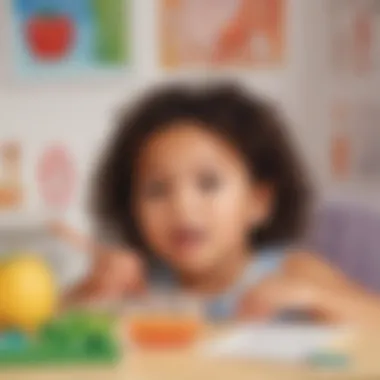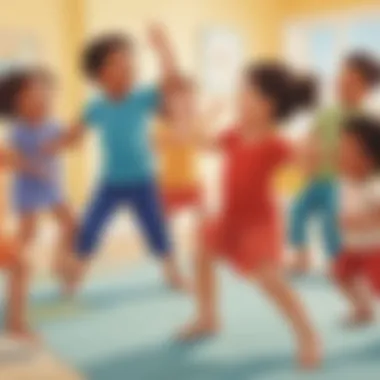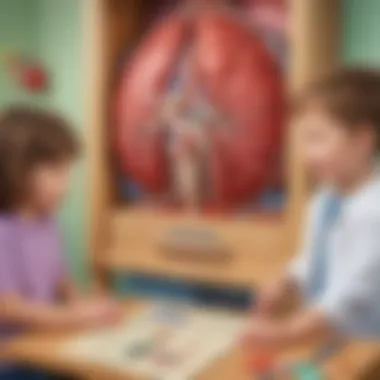Engage Preschoolers with Fun Human Body Activities for Learning


Fun Activities Ideas
For preschoolers, engaging in activities that involve the human body can nurture their curiosity and aid in their development. Let's explore a range of exciting activities that are both entertaining and educational.
Indoor Activities
1. Simon Says: This classic game challenges children to follow commands, enhancing their listening skills and promoting body awareness.
2. Yoga for Kids: Introduce simple yoga poses that mimic animals or objects, encouraging flexibility and mindful movement.
Outdoor Adventures
1. Nature Scavenger Hunt: Take children outside to explore and hunt for natural objects, fostering an appreciation for the environment.
2. Obstacle Course: Set up a mini obstacle course to boost gross motor skills and physical agility.
Arts and Crafts
1. Body Tracing: Have kids lie down on a large piece of paper and trace their bodies, allowing them to see and understand their physical dimensions.
2. Collage Creations: Create collages using cutouts of body parts to learn about anatomy in a fun, artistic way.
Science Experiments
1. DIY Lung Model: Construct a simple lung model using balloons to demonstrate how lungs inflate and deflate during breathing.
2. Taste Test: Explore the sense of taste by having children sample different flavors and categorize them based on taste.
Cooking and Baking
1. Shape Cookies: Bake cookies in various body shapes and teach children about different body parts while decorating.
2. Fruit Skeletons: Create edible fruit skeletons to introduce kids to the skeletal system in a tasty manner.
These engaging activities not only entertain but also educate preschoolers about their amazing human bodies.
Introduction
In this article, we delve into a variety of engaging human body activities specifically curated for preschoolers. The activities highlighted aim to promote learning through play, foster curiosity, and enhance fine and gross motor skills development in young children. It is crucial to provide opportunities for preschoolers to explore and understand their bodies in a fun and interactive manner, setting the foundation for a lifelong interest in health and biology.
Welcome to Gigglyx
Welcome to Gigglyx, a whimsical world where preschoolers embark on a fascinating journey to discover the wonders of the human body. At Gigglyx, learning becomes an adventure filled with excitement and exploration. Through a series of hands-on activities and games, children are not only entertained but also educated about their own anatomy.


In Gigglyx, children are encouraged to use their senses to understand the world around them. From feeling different textures to identifying scents and tasting new flavors, every experience is designed to ignite curiosity and spark imaginations. Gigglyx is a place where learning is disguised as play, making education enjoyable and memorable for young minds.
At Gigglyx, we recognize the importance of holistic development, which is why our activities encompass not just academic learning but also the enhancement of motor skills. Through engaging in various games and challenges, children improve their coordination, balance, and fine motor abilities, setting them up for success in both academic and physical pursuits.
Join us at Gigglyx, where every activity is a step towards cultivating a lifelong love for learning and a deeper understanding of the marvelous human body.
Understanding the Human Body
In this exploration of human body activities for preschoolers, understanding the human body is a fundamental aspect that lays the foundation for the educational journey ahead. By introducing young minds to the basics of anatomy, children can develop a sense of self-awareness and comprehend how their bodies function. This section delves into the significance of teaching preschoolers about their bodies, instilling knowledge that will benefit them throughout their lives. A key element of this topic is to empower children to recognize body parts, fostering a sense of identity and curiosity about the human form. By grasping these concepts early on, preschoolers can build a strong knowledge base that sets the stage for further learning and exploration. Understanding the human body not only aids in physical development but also promotes cognitive growth as children engage with hands-on activities that stimulate their curiosity.
Introduction to Body Parts
Introducing preschoolers to different body parts is a vital step in their educational journey. By familiarizing children with names and functions of body parts, educators can enhance language development and vocabulary acquisition. This section focuses on engaging children in interactive learning experiences that make discovering body parts fun and exciting. Through activities like 'Guess the Body Part' games and 'Label the Body' worksheets, preschoolers can actively participate in learning about their bodies. Understanding body parts is not solely about identification but also about promoting a sense of body positivity and self-confidence. By encouraging preschoolers to appreciate their bodies and understand how each part contributes to their overall well-being, educators can nurture a positive body image from an early age. Emphasizing the importance of each body part in everyday activities like eating, playing, and moving helps preschoolers connect anatomical knowledge to real-world experiences, fostering a holistic understanding of their bodies.
Sensory Activities
Sensory activities play a pivotal role in the holistic development of preschoolers by engaging their senses and promoting cognitive growth. In this article, we delve into the significance of sensory exploration for young learners, focusing on enhancing their learning experience through hands-on activities that stimulate their sensory receptors. These activities not only facilitate the understanding of the human body but also nurture a sense of curiosity and discovery in children.
Exploring the Sense of Touch
Tactile Sensory Bins
Tactile sensory bins provide a hands-on approach to sensory play, allowing preschoolers to explore various textures and materials. The tactile stimulation offered by sensory bins contributes to the development of fine motor skills and sensory processing abilities in children. These bins are carefully curated to offer a wide range of tactile experiences, from smooth to rough textures, fostering sensory exploration and tactile discrimination. The versatility of tactile sensory bins makes them a popular choice for educators and caregivers looking to engage preschoolers in meaningful sensory activities.
Texture Matching Games
Texture matching games stimulate tactile perception and cognitive skills in preschoolers by requiring them to identify and match textures based on their sense of touch. These games encourage sensory exploration and cognitive development while providing a fun and engaging way to improve tactile discrimination. The unique feature of texture matching games lies in their ability to challenge children's sensory perception and sharpen their tactile sensitivity. Integrating texture matching games into sensory activities enhances the overall learning experience for preschoolers, making it a valuable inclusion in this article.
Enhancing Visual Perception
Eye Spy Nature Walk
An eye spy nature walk is a captivating sensory activity that integrates visual perception with outdoor exploration. This activity stimulates children's observation skills and encourages them to notice details in their natural surroundings. The key characteristic of an eye spy nature walk is its ability to engage preschoolers in active visual exploration, fostering a greater appreciation for nature and developing their visual acuity. The unique feature of this activity lies in its combination of physical exercise and visual stimulation, making it a beneficial choice for promoting outdoor learning experiences.
Visual Discrimination Activities
Visual discrimination activities focus on enhancing children's ability to differentiate between visual stimuli, such as shapes, colors, and patterns. These activities challenge preschoolers to identify visual variations and make distinctions based on visual cues. The key characteristic of visual discrimination activities is their contribution to fine-tuning cognitive skills and visual acuity in young learners. By engaging in visual discrimination tasks, children hone their ability to perceive and interpret visual information accurately, making these activities a valuable addition to sensory exploration in this article.
Engaging the Sense of Smell
Scented Playdough Creations
Scented playdough creations combine olfactory stimulation with hands-on creativity, offering a multisensory experience for preschoolers. The aroma of scented playdough enhances sensory engagement and encourages imaginative play, providing children with a novel way to explore the sense of smell. The key characteristic of scented playdough creations is their ability to evoke sensory memories and create a sensory-rich environment for young learners. While the advantages of scented playdough include promoting sensory integration and creative expression, considerations such as allergies and sensitivities should be acknowledged when incorporating them into sensory activities.
Guess the Scent Game


The guess the scent game is a playful sensory activity that challenges children to identify various scents through olfactory perception. This game stimulates the sense of smell and encourages preschoolers to rely on their olfactory memory to guess different scents accurately. The unique feature of the guess the scent game is its interactive nature, fostering a sense of excitement and discovery during sensory exploration. While this game promotes olfactory awareness and memory recognition, considerations regarding the selection of scents and individual preferences should be addressed to ensure a positive sensory experience for all participants.
Exploring Taste
Healthy Snack Adventures
Healthy snack adventures introduce preschoolers to a variety of nutritious foods while encouraging them to explore different tastes and flavors. These culinary experiences not only support healthy eating choices but also provide sensory stimulation through taste exploration. The key characteristic of healthy snack adventures is their role in promoting healthy eating habits and expanding children's palate for a diverse range of foods. While taste test exploration offers a hands-on approach to sensory learning, considerations such as food allergies and dietary restrictions should be prioritized to ensure a safe and enjoyable culinary journey for all participants.
Taste Test Exploration
Taste test exploration involves conceptualizing various taste profiles and textures through sensory sampling and comparison. This activity inspires preschoolers to engage in mindful eating practices while sharpening their taste perception and discrimination skills. The unique feature of taste test exploration is its interactive nature, prompting children to actively participate in identifying and evaluating different tastes. Integrating taste test exploration into sensory activities not only heightens taste awareness but also cultivates a sense of culinary curiosity and appreciation for diverse flavors, making it a valuable experiential learning opportunity for preschoolers in this article.
Movement and Motor Skills
Gross Motor Activities
Obstacle Course Challenge
The Obstacle Course Challenge stands out as an exciting and dynamic activity that contributes significantly to the overall goal of enhancing Movement and Motor Skills in preschoolers. This activity focuses on creating physical hurdles and obstacles that children navigate through, encouraging agility, spatial awareness, and strategic thinking. The key characteristic of the Obstacle Course Challenge lies in its ability to improve gross motor skills such as running, jumping, and climbing, ensuring a holistic development approach.
The Obstacle Course Challenge is a popular choice for this article due to its versatility and adaptability to different environments and skill levels. It offers an inclusive experience where children of varying abilities can participate and thrive. One unique feature of the Obstacle Course Challenge is its potential to stimulate imaginative play and cooperative learning among preschoolers. While the advantages of this activity include promoting cardiovascular health and muscle strength, some considerations revolve around safety measures and age-appropriate obstacle designs.
Balloon Volleyball Game
The Balloon Volleyball Game provides a fun and interactive way to enhance gross motor skills and hand-eye coordination in preschoolers. This game involves using balloons as soft
Educational Body Systems Exploration
Learning about the Skeletal System
X-Ray Art Activity:
The X-Ray Art Activity holds a special place in this article as it provides a creative and visually engaging way for preschoolers to learn about the skeletal system. By using materials that mimic the transparency of X-rays, children can assemble and observe skeletal structures, promoting a deeper understanding of bone composition and function. This activity fosters spatial awareness, fine motor skills, and anatomical knowledge in a playful yet educational manner. Its hands-on nature encourages active participation and allows children to grasp abstract concepts in a tangible way, making learning about bones exciting and memorable. The X-Ray Art Activity stands out for its interactive approach and ability to stimulate children's curiosity while promoting scientific literacy.
Skeletal Puzzle Play:
Another essential component of exploring the skeletal system, the Skeletal Puzzle Play activity offers a hands-on exploration of bone arrangement and connections. By piecing together skeletal puzzles, preschoolers can actively engage with the concept of the skeleton as a whole, understanding how individual bones fit together to form a functional framework. This activity enhances problem-solving skills, spatial reasoning, and fine motor dexterity as children manipulate puzzle pieces to complete the skeleton. Skeletal Puzzle Play provides a tactile and collaborative learning experience, encouraging teamwork and communication among young learners. Its intuitive design and emphasis on structural comprehension make it a valuable addition to this article, fostering a deeper appreciation for the skeletal system in preschoolers.
Discovering the Digestive System
Digestive System Simulation:
The Digestive System Simulation featured in this article offers a hands-on approach to understanding the complex process of digestion. Through interactive recreations of the digestive tract, preschoolers can follow the journey of food from ingestion to absorption, gaining insights into the role of each organ in breaking down nutrients. This activity not only educates children about the importance of good nutrition but also emphasizes the interconnected nature of the digestive system. By engaging in hands-on simulations, young learners develop a deeper understanding of how different body parts work together to maintain health and vitality. The Digestive System Simulation promotes sensory exploration, critical thinking, and knowledge retention, making it a valuable tool for educating preschoolers about the intricacies of digestion.


Food Journey Experiment:
A unique and engaging activity included in this article, the Food Journey Experiment invites preschoolers to participate in a sensory exploration of food and its passage through the digestive system. By simulating the digestive process using everyday food items, children can visualize the transformation of food from chewed morsels to essential nutrients. This experiment not only reinforces concepts related to digestion but also encourages children to make healthy food choices and understand the impact of diet on overall well-being. The Food Journey Experiment sparks curiosity, encourages scientific inquiry, and promotes a holistic understanding of nutrition and digestion. Its hands-on nature and real-life application make it a valuable educational tool for enriching preschoolers' knowledge of the digestive system.
Creative Arts Integration
Creative Arts Integration plays a vital role in enhancing the learning experience of preschoolers within the context of exploring human body activities. By incorporating artistic elements, such as drawing, painting, and sculpting, children can express themselves creatively while delving into the wonders of the human body. Engaging in artistic activities not only stimulates the imagination but also encourages holistic development by merging cognitive and emotional aspects of learning. Through Creative Arts Integration, preschoolers can gain a deeper understanding of human anatomy in a visually stimulating and interactive manner, fostering a multidimensional approach to education.
Furthermore, integrating creative arts into the exploration of the human body provides children with a unique avenue to communicate their perceptions and interpretations of biological concepts. By allowing kids to visually represent body parts, functions, and systems through art, educators facilitate a deeper connection between abstract knowledge and tangible artistic expression. This hands-on engagement enables preschoolers to internalize complex information in a meaningful way, bridging the gap between theoretical learning and practical application.
Considering the benefits of Creative Arts Integration, educators and caregivers should recognize the power of art in nurturing children's creativity, critical thinking, and sensory exploration. Through art activities that focus on the human body, young learners can develop a sense of curiosity, observation, and self-expression, laying a strong foundation for future academic and artistic pursuits. The inclusiveness of art in educational initiatives not only enhances cognitive development but also cultivates a sense of appreciation for the beauty and complexity of the human form.
Artistic Expressions of the Body
Artistic Expressions of the Body encompass a diverse range of creative activities that enable preschoolers to explore and represent different facets of human anatomy through art. By encouraging children to visually interpret and depict body structures, organs, and functions, educators and parents can facilitate a deeper comprehension of biological concepts in an engaging and expressive manner. Through art, preschoolers can transform abstract knowledge into tangible creations, fostering a memorable and personal connection to the human body.
Activities under Artistic Expressions of the Body may include drawing self-portraits, creating body tracing art, or sculpting anatomical models using clay or playdough. These hands-on projects not only enhance fine motor skills but also promote spatial awareness and attention to detail as children strive to accurately represent the human body in their artwork. By encouraging artistic exploration of the body, educators can cater to diverse learning styles and preferences, providing a dynamic and inclusive educational experience for young learners.
Moreover, Artistic Expressions of the Body serve as a platform for preschoolers to engage in imaginative play and storytelling centered around human anatomy. By inviting children to narrate stories related to their artistic creations, educators can encourage language development, creativity, and narrative skills, fostering a comprehensive understanding of the interconnectedness between art and anatomy. Through artistic expression, preschoolers can convey their perceptions, emotions, and knowledge of the human body in a non-verbal yet profound manner, enriching their learning journey.
Conclusion
In this final section of the article, we bring together the essential concepts and experiences shared in the exploration of human body activities for preschoolers. The importance of concluding this journey lies in consolidating the key learnings and insights gained throughout the different sections. By reflecting on the various sensory, motor, educational, and creative aspects covered, we offer a holistic view of how engaging with the human body can benefit preschoolers.
One crucial element emphasized throughout is the emphasis on hands-on learning. By actively participating in activities that stimulate their senses and movement, children absorb information more effectively than traditional methods. This hands-on approach not only enhances their understanding of the human body but also fosters a sense of curiosity and exploration, vital for their development.
Moreover, the benefits of these activities extend beyond mere knowledge acquisition. They contribute to the enhancement of fine and gross motor skills, essential for physical development in preschoolers. From building skeletal structures to identifying sensory experiences, each activity serves a dual purpose of education and skill development.
When considering implementing these activities with preschoolers, it is important to take into account their individual needs and preferences. Customizing the experiences to suit their interests can further enrich their learning journey. Additionally, creating a safe and supportive environment for exploration ensures that children feel encouraged to engage and learn actively.
In essence, the conclusion of this article underscores the significance of hands-on, sensory-rich experiences in educating preschoolers about the human body. By embracing a playful and interactive approach, we not only impart valuable knowledge but also spark a lifelong curiosity for learning in young minds.
Wrap-Up of Human Body Adventures
Closing the curtain on our human body adventures for preschoolers, we revisit the array of activities and experiences that have enriched their understanding of this complex subject. From tactile sensory bins to gross motor challenges, each adventure was thoughtfully designed to engage multiple senses and motor skills simultaneously.
By delving into the artistic expressions of the body, preschoolers had the opportunity to explore their creativity and imagination in connection with anatomical concepts. Through various mediums such as drawing, sculpting, and painting, children infused art with science, creating a harmonious blend of self-expression and learning.
As we wrap up these adventures, it is important to acknowledge the efforts put into crafting age-appropriate, engaging activities that cater to the developmental needs of preschoolers. By integrating educational content with interactive experiences, we strived to make the learning process seamless, enjoyable, and memorable.
Reflecting on the wrap-up of human body adventures, we applaud the curiosity, enthusiasm, and eagerness with which preschoolers embraced each activity. Their sheer joy in discovering the intricacies of the human body serves as a testament to the success of these endeavors.
Continue the Exploration
While we conclude our current exploration of human body activities for preschoolers, the journey towards understanding and discovery continues infinitely. To sustain the momentum of learning initiated through the activities discussed in this article, it is essential to foster a culture of exploration and inquiry in young learners.
Parents, teachers, and guardians are encouraged to leverage the insights gained from these activities to create further opportunities for engagement and learning. By building upon the foundational knowledge acquired, children can embark on new adventures that stimulate their curiosity and expand their understanding of the human body.
Continuing the exploration involves seeking out new challenges, resources, and experiences that align with the interests and developmental stages of preschoolers. Whether through nature walks, scientific experiments, or artistic projects, every engagement contributes to their holistic growth and learning.
In essence, the journey of exploration is a continuous and dynamic process that evolves with each new discovery. By nurturing a sense of wonder and inquisitiveness in preschoolers, we pave the way for a lifelong pursuit of knowledge and understanding about the complexities of the human body.



